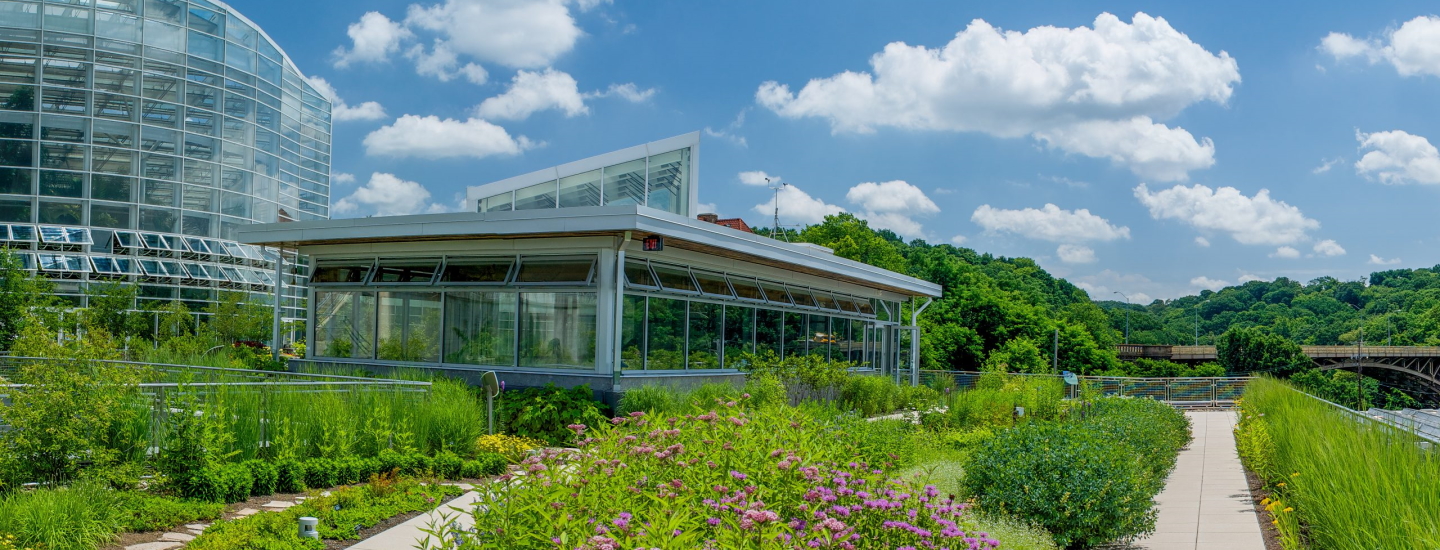Center for Sustainable Landscapes

|
| In February 2020, it was reported that The Center for Sustainable Landscapes had been awarded a BREEAM Outstanding rating, placing it in the top 1% of buildings globally for building performance. Photo: Paul G Weigman. |
Phipps Conservatory and Botanical Gardens, a globally-recognised green leader in sustainability and BRE Global, a world leading, multi-disciplinary building science organisation, announced that the Center for Sustainable Landscapes (CSL) has been certified using the BREEAM USA standard for existing buildings. The CSL is the first building in the United States to achieve a BREEAM Outstanding rating and the first building certified under BREEAM in the state of Pennsylvania.
BREEAM was developed in 1990 by BRE Global, the first assessment method for buildings in the world. Today BREEAM is internationally recognised as the most comprehensive and holistic environmental assessment method, with more than 2,280,000 registered projects and more than 570,000 certified buildings across 85 countries.
The Center for Sustainable Landscapes is a 24,350-square-foot education, research and administration facility at Phipps Conservatory and Botanical Gardens, a public garden attraction in Pittsburgh, Pennsylvania. Designed and built to generate all of its own energy, and treating and reusing all water captured on-site, it was the first facility in the world to meet four of the world’s highest green construction standards – The Living Building Challenge, WELL Building Platinum, SITES Platinum and LEED® Platinum – and it now adds BREEAM Outstanding In-Use to its resume.
BREEAM In-Use assesses and rates the performance of existing buildings around the world. BREEAM USA In-Use has been adapted to reflect differences in American standards and practices while still providing the global comparability and rigour that distinguishes the BREEAM standard. Certification is achieved through independent, third-party assessment conducted on site, giving stakeholders confidence about their building’s performance and recognition that a building meets, and continues to meet, the robust BREEAM In-Use sustainability standards.
Richard Piacentini, Phipps’ president and CEO said: “At Phipps, we believe that public gardens have a role to play in mitigating the challenge of climate change, and we believe the answer lies in regenerative thinking that extends to our buildings, programs and operations. The achievement of the BREEAM rating helps us to communicate the value of green building to new audiences while placing us in the company of some of the world’s most innovative sustainable building projects.”
3R Sustainability supported the Phipps team throughout the assessment process and the certification was carried out by BREEAM USA In-Use licensed Assessor Julia Craighill of Ensight Consulting.
Kathy Hrabovsky, 3R’s Sustainability Manager and Project Lead said: “The Phipps Center for Sustainable Landscapes (CSL) is an exceptional example of what can be achieved when a building is not only designed with high performance in mind, but is held to the highest standard for building operations.”
Shamir Ghumra, Director of BREEAM at BRE Global said, “This is a significant achievement and another milestone for BREEAM in America. The Phipps team, working closely with Julia Craighill at Ensight Consulting, have gone beyond best practice and have really set the bar in terms of the BREEAM rating achieved. With so many visitors coming to Phipps every year we hope that this certification will inspire others to do the same.”
This article originally appeared as 'Phipps Conservatory achieves highest BREEAM In-Use rating in the United States', published on the BREEAM website on 21 February 2020.
[edit] Related articles on Designing Buildings Wiki
Featured articles and news
Professional practical experience for Architects in training
The long process to transform the nature of education and professional practical experience in the Architecture profession following recent reports.
A people-first approach to retrofit
Moving away from the destructive paradigm of fabric-first.
International Electrician Day, 10 June 2025
Celebrating the role of electrical engineers from André-Marie Amperè, today and for the future.
New guide for clients launched at Houses of Parliament
'There has never been a more important time for clients to step up and ...ask the right questions'
The impact of recycled slate tiles
Innovation across the decades.
EPC changes for existing buildings
Changes and their context as the new RdSAP methodology comes into use from 15 June.
Skills England publishes Sector skills needs assessments
Priority areas relating to the built environment highlighted and described in brief.
BSRIA HVAC Market Watch - May 2025 Edition
Heat Pump Market Outlook: Policy, Performance & Refrigerant Trends for 2025–2028.
Committing to EDI in construction with CIOB
Built Environment professional bodies deepen commitment to EDI with two new signatories: CIAT and CICES.
Government Grenfell progress report at a glance
Line by line recomendation overview, with links to more details.
An engaging and lively review of his professional life.
Sustainable heating for listed buildings
A problem that needs to be approached intelligently.
50th Golden anniversary ECA Edmundson apprentice award
Deadline for entries has been extended to Friday 27 June, so don't miss out!
CIAT at the London Festival of Architecture
Designing for Everyone: Breaking Barriers in Inclusive Architecture.
Mixed reactions to apprenticeship and skills reform 2025
A 'welcome shift' for some and a 'backwards step' for others.






















